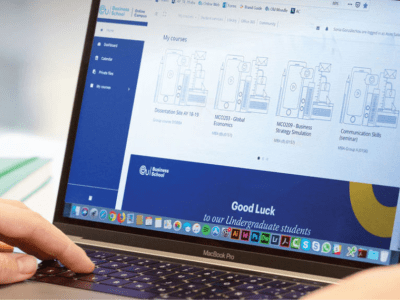How to Build and Lead Highly Effective Teams With Dagmara Asbruek
What does the phrase “highly effective team” bring to mind for you? Do you think of “effectiveness” in terms of a team’s ability to consistently meet performance targets? Perhaps you believe that an effective team is made up of members that work harmoniously together. Or maybe you value the ability to follow instructions closely.
While these definitions aren’t incorrect, none paints a complete picture of what an ideal team looks like. Effective teamwork is integral to an organization’s success. And business leaders that fully understand how to build and manage teams effectively will almost certainly be viewed as invaluable assets by their employers.
We invited Dagmara Asbruek to join us at EU Business School to discuss these important points and describe how team managers can become better leaders.
Dagmara Asbruek is a global procurement officer for Kongsberg Automotive, where she leads two purchasing teams and reports directly to the Vice President of Global Project Procurement. She has worked in the automotive and procurement spaces for over fifteen years, combining various governance, project management and cross-cultural leadership skills (Dagmara speaks five languages).
Dagmara opened her presentation by highlighting the central roles that teams play in organizations of all types and sizes.
Teams: The Engines of Organizational Success
Dagmara began by describing teams as “engines of organizations”. While people are crucial “assets”, she said, it’s teams that ultimately determine a project’s success. Because of this, teams need to work effectively within a company.
Building productive, competent teams, however, is easier said than done. When individuals take leadership positions, there are often many unknowns. Talking from personal experience, Dagmara noted that on multiple occasions she had found herself in management roles without the necessary tools and understanding that she required to “steer the ship”.
What Is a High Performing and Effective Team?
Before sharing the tools and strategies that she has found useful throughout her career, Dagmara defined the term “highly effective team”.
She posed the question, “What pictures, symbols and words come to mind when you imagine a highly effective and cohesive team?”
The presentation attendees came up with many responses, including “motivation”, “strong leadership”, “an orientation towards results”, “good time management”, “loyalty”, “determination”, and more. Dagmara used this exercise to illustrate how many varying ideas exist about what the term “effective team” means and how challenging it is to find a universal definition.
Dagmara proposed an answer to the question above that encompasses eight core features and bridges the gaps between different understandings:
- Consistency
- Collaboration and interdependence
- Collective value-creation
- Strong stakeholder connection and communication
- Usage of the team’s talents
- High levels of trust, support and care
- High levels of individual engagement
- Overall satisfaction and sense of meaning
In Dagmara’s estimation, teams that display the eight characteristics described above can accurately be described as “highly effective”. She argued that the leader’s role is to create a space in which these features can grow and evolve.
How Do You Create a High Performing and Effective Team
Using Peter Hopkin’s model, “5 Disciplines of High Performing Teams”, Dagmara outlined five foundational elements that need to be present for a team to be effective.
- Clarity – “Clarity” refers to a team’s mission. If a team doesn’t know its reason for existing, it will be difficult to coordinate initiatives and behavior. “Clarity” also refers to the need for clear, specific goals and corresponding processes for achieving them.
- Commissioning – “Commissioning” means clearly defining a team’s contribution to the broader organization. Having this understanding within a group is imperative for maintaining motivation and ensuring that the team is valued by other departments and stakeholders.
- Co-Creating – “Co-creation” is about the parameters which determine how team members work together, including activities like collaboration, meetings, communication and so on.
- Connecting – “Connecting” refers to interactions outside of the team, such as with other departments, suppliers, contractors and stakeholders. It is important for leaders to create a culture and set of expectations that encourage positive communication.
- Learning – Learning sits at the center of the five-part model of effective team building. “Learning” is about building effective training, mentorship and feedback mechanisms to ensure consistent growth and development.
Dagmara then shared Peter Lencioni’s model of culture dynamics and positive co-creation, which further elaborates on the underpinnings of successful teams. The model has five aspects:
- Attention – For a team to be effective and move in one direction, it needs to pay “attention” to clearly defined, agreed-upon goals.
- Accountability – Accountability Is about creating an environment in which people are recognized as being responsible for their actions. In this way, low standards are eliminated through mutual cooperation and challenge.
- Commitment – Commitment refers to a willingness among team members to commit and follow through on a decision once it has been made, even if everybody is not happy.
- Productive conflicts – A desire to cultivate productive conflict entails the removal of artificial harmony. Healthy disagreement that drives creative progress towards solutions is valued in this context.
- Vulnerability-based trust – Vulnerability-based trust creates a space where people are not afraid to share their weaknesses and vulnerabilities.
Dagmara highlighted the fact “vulnerability-based trust” is the most critical factor of this pyramid. It acts as the basis for all other elements. As such, leaders need to focus on building trust as their first priority. And it’s onto this topic that Dagmara next turned her attention.
Leading an Effective Team: Dos and Don’ts of Building Trust
There are several ways that leaders can build a solid foundation of trust and vulnerability that will allow teams to thrive. Dagmara outlined six key points:
- Take off your mask – As a leader, you need to demonstrate vulnerability first if you want your team members to follow suit. In practical terms, this means being honest about your weaknesses, flaws and aspects of your personal life (when it is appropriate to share these details).
- Admit your mistakes – If you make mistakes as a leader, don’t be afraid to share them with the team. This practice cultivates a culture of sharing and removes any fear around making mistakes, which can detrimentally affect results and performance.
- Listening – Dagmara spoke about a personal experience in regards to listening. When she became a coach, she discovered the importance of recognizing others’ feelings, creating time and space for team members and asking questions to ensure that her understanding was correct. She recommends that all leaders should develop these “soft” skills.
- Asking for feedback – Every effective team operates in a culture of feedback. And team leaders should be the first people to ask for feedback. This can be done in many ways, including in one-on-one formats and through surveys. Working from this basis, leaders can also encourage team members to share constructive feedback among themselves.
- Building relationships – Connecting with colleagues on a personal basis is vital for successful long-term collaboration. As a leader, you should develop relationships with your team that extend beyond business goals and processes. You should, for example, get to know your team members’ values, interests and personal stories.
- Create a space for quality time – Create a supportive space where you can share time with your team outside of a business context. In this way, you will gradually cultivate lasting trust and vulnerability.
Dagmara finished her presentation by outlining five things that all leaders should avoid. If you find yourself falling into these traps, it is a good sign that you need to work on and develop your management style.
Dagmara listed five “don’ts” of effective leadership:
- Don’t point fingers and blame people, which will undermine trust.
- Don’t tell people how to do their job without listening to feedback.
- Don’t try to present a false, inauthentic mask to team members.
- Don’t over-focus on business tasks at the expense of quality time with team members.
- Don’t rely on external trainers to implement team-building and training exercises.
Dagmara rounded off by highlighting the importance of small steps. Over time, small actions will contribute towards a foundation of trust, collaboration and mutual respect.
Become a Word-Class Business Leader at EU Business School
Do you envision yourself in a leadership role, perhaps at a large enterprise, a mission-driven non-profit, or at the head of your own startup? If the answer is yes, a degree from EU Business School will provide you with all the skills and experience you need to thrive in your chosen field.
We offer a range of leadership courses, including our BA (Hons) in Business Management (International Business), Master in Management, and MBA in Human Resources Management. You can choose to study in one of EU Business School’s European campuses, located in the thriving business hubs of Barcelona, Geneva, Montreux and Munich, as well as online.










